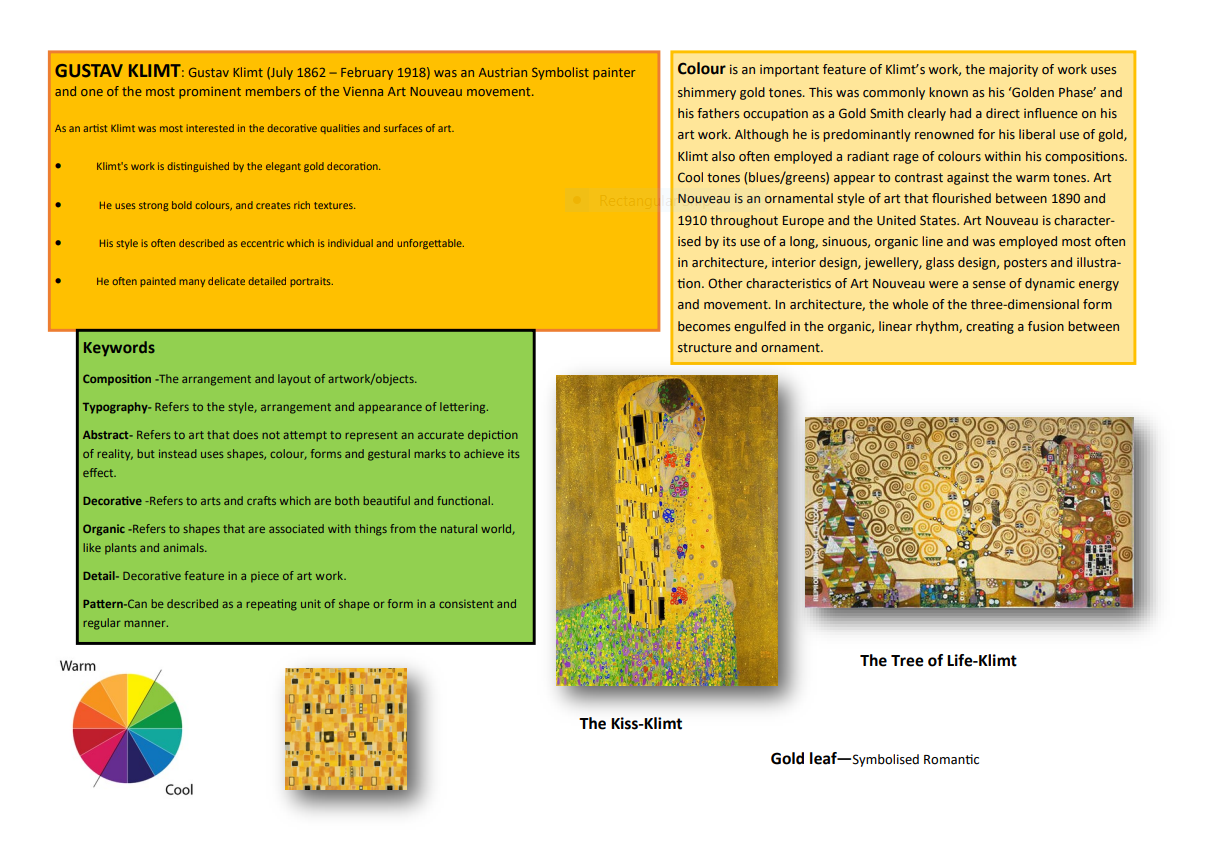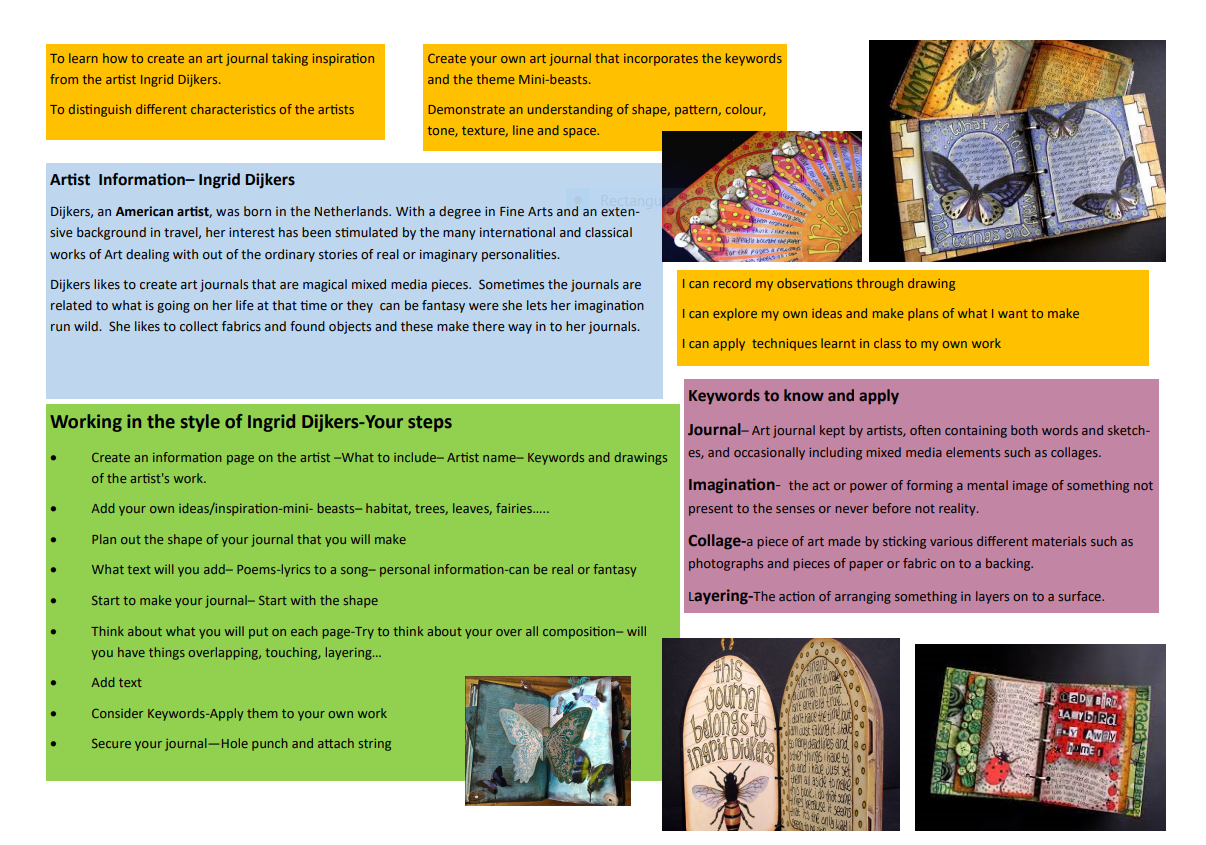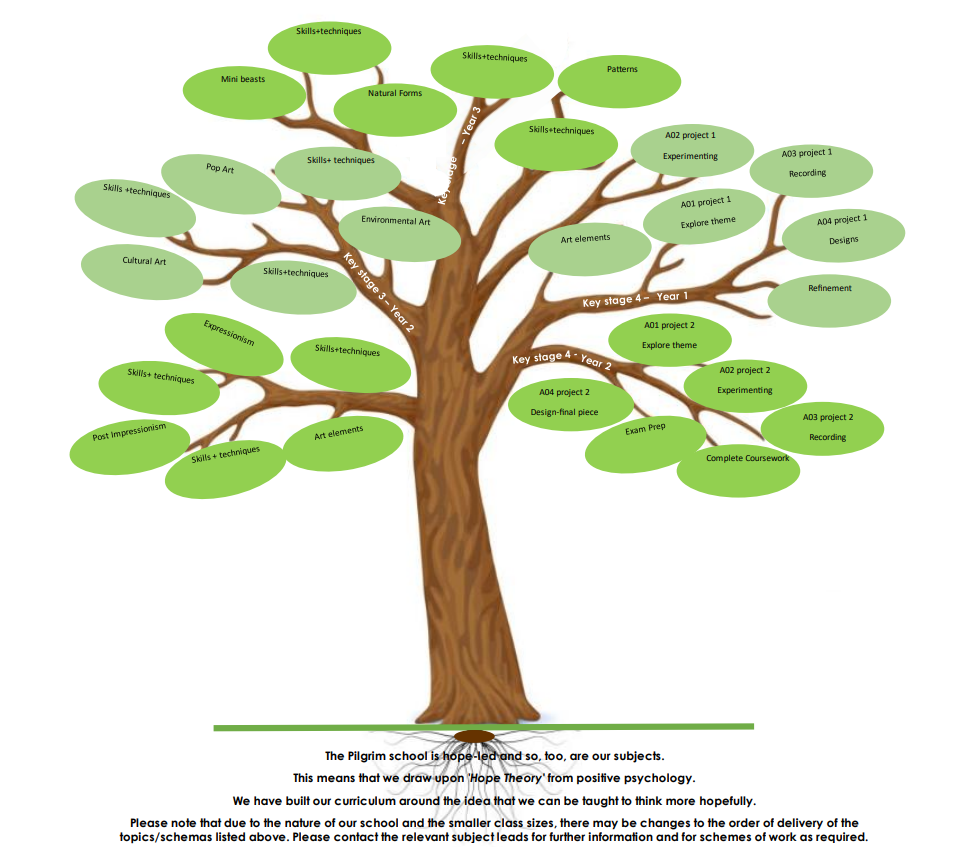Art
“Art is not what you see, but what you make others see”
Edgar Degas
Introduction
Art provides the opportunity to demonstrate imagination and creative flair. Through our Art curriculum, pupils develop and refine their drawing and observational skills through their exploration of drawing. Pupils have the opportunity to experiment with and select methods, approaches, ideas and feelings to create compositions for paintings, collages and other creative responses. They are encouraged to explore their artistic styles by studying a range of artists and their ‘drawing and making’ styles.
The art curriculum embraces the school’s vision for Hope by highlighting artists' hopeful stories and taking what we can learn from these. The art curriculum also builds in opportunities for students to explore British Values such as-
- Freedom to voice opinions during group critiques/feedback/self-assessment and peer assessment,
- Sharing work and ideas,
- Respecting each other’s strengths and weaknesses and many more.
Goal
We have a line of sight and a scheme of work at KS3 and KS4. This line of sight is flexible as it can be adapted to suit the needs of our students. There are knowledge organisers to support the knowledge and skills being learnt.
Example Schema


Pathways
At KS3, students will follow a programme of study that links to the national curriculum. Students will build skills in, understanding and knowledge in a wide range of art forms. They will create artwork recognising the key principles - The Formal Elements, which are line, shape, form, tone, texture, pattern, colour, composition and many more. They are often used together, and how they are organised in a piece of art determines what the finished piece will look like. These elements are developed and built upon so that the skills and applications that students acquire become more complex and accomplished over the course of KS3, whilst being assessed on skills such as - knowledge, evaluating, generating ideas, and making.
Students will learn skills and techniques in line with the national curriculum that will engage, inspire and challenge, equipping them with the knowledge and skills to experiment, invent and create their own works of art that will prepare them to study the subject at GCSE.
Pathways KS3
Students join at different points in the year and some students will have poor attendance due to ill health. Each of the students starting points can be different. Therefore it is important to cover the art building blocks throughout each project, so each student is equipped with the skill and knowledge required to achieve their full potential in this subject.
Throughout each year, students will cover 3 projects in line with the national curriculum. This outline is structured at years 1, 2, 3, covering one project over two terms. This will not necessarily be followed rigidly due to nature of the school and the timings students join.
Assessment KS3
KS3 will be assessed on skills such as - knowledge, evaluating, generating ideas, and making.
Assessment at KS3 familiarises students with the framework for assessment at GCSE covering 4 AOs: developing ideas, refining ideas, recording ideas and presenting.
Pathways KS4
It is important for students to consider GCSE Art & Design as an option if they are interested in pursuing a career in the arts. For example, Architecture, Fashion Design, Game Designer, Interior Design, Graphics and Illustration etc. GCSE art entails a broad course which gives students the opportunity to explore a range of practical skills.
As a school we will follow the AQA Fine Art aspect of the Art and Design GCSE course.
Fine art may be defined as work which is produced as an outcome of the students’ personal experience, rather than that which is created exclusively for a practical function, or that which is the outcome of a tightly prescribed brief. It is a means by which ideas are explored, communicated and, through visual information and enquiry, translated into art outcomes. Work produced for this will demonstrate the use of formal elements and creative skills, and give visual form to individual thoughts, feelings, observations and ideas. Students will show evidence of trying to extend their own and others’ ways of seeing the world. They will use the visual language of the subject sensitively and thoughtfully to support their intentions.
There are 2 units to complete:-
Unit 1: Portfolio of Work (60%):
This work is internally set and assessed. Students explore a range of media and processes on two themes (two projects) one being extended to include a final outcome. They will record ideas and all preparatory work in sketchbooks and on paper of any size. This is based on any theme chosen by the student. This allows for choice/preference/engagement and for students who arrive with us at different times of the year with GCSE coursework already started from their mainstream school to slot in. This also allows us as a school to embrace what knowledge and experiences the students are bringing to the course. Sometimes the student will choose to focus on a theme that might be personal to them. The scheme at any given time must be adapted to the needs of the individual and to what has already been completed to date to allow for successful completion of the course and to fill in any missing gaps for this evidence-based course.
The portfolio of work will show an explicit coverage of the four assessment objectives. It will include a sustained project evidencing the journey from initial engagement to the realisation of intentions and a selection of further work undertaken during the student’s course. The work produced will be marked using the following Assessment Objectives-:
- A01 Developing ideas through investigations, demonstrating critical understanding of sources.
- A02 Refining work by exploring ideas, selecting and experimenting with appropriate media, materials, techniques and processes.
- A03 Recording ideas, observations and insights relevant to your intentions as work progresses.
- A04 Presenting a personal and meaningful response that realises intentions and demonstrates understanding of visual language.
Unit 2 Externally Set Task (40%):
Students respond to their chosen starting point on the exam paper (Choice of 7 themes) which gets released in January. They will do all the prep work from January until Easter and then they will sit the exam where they will produce a personal response (final outcome) to their project. The exam lasts for 10 hours under examination conditions. This can be spread out over two days. See AQA specification for more detail.
Assessment
Students receive written and verbal feedback from the teacher to help guide their journey. Their levels are reviewed on a regular basis, so there are always opportunities for students to revisit and improve on earlier work.
Agency
The GCSE qualifications in Art and Design will allow students to go on and study an art-based course at Post-16 and it will also help enhance research skills, analytical skills, independent and creative thinking skills and time management skills – all of which are very useful whatever courses students go on to study.
Careers in Art and Design include; Game Designer, Fine Artist, Illustrator, Fashion Designer, Theatre Design, Interior Architecture, Architecture, Photographer, Teacher, Graphic Designer and many more.

